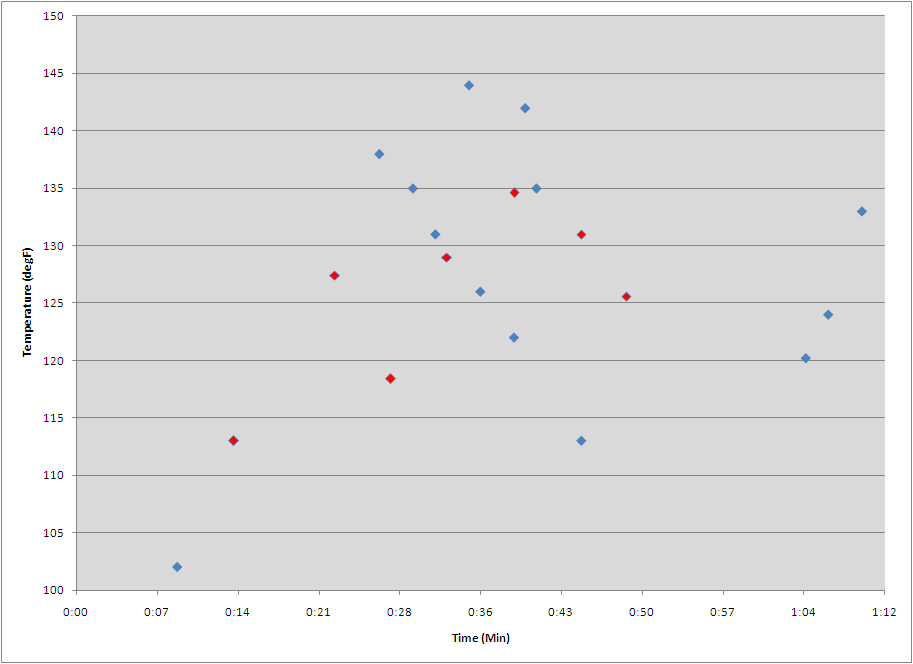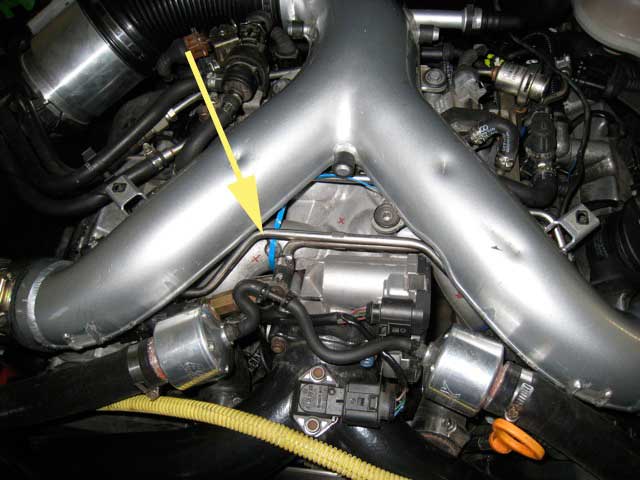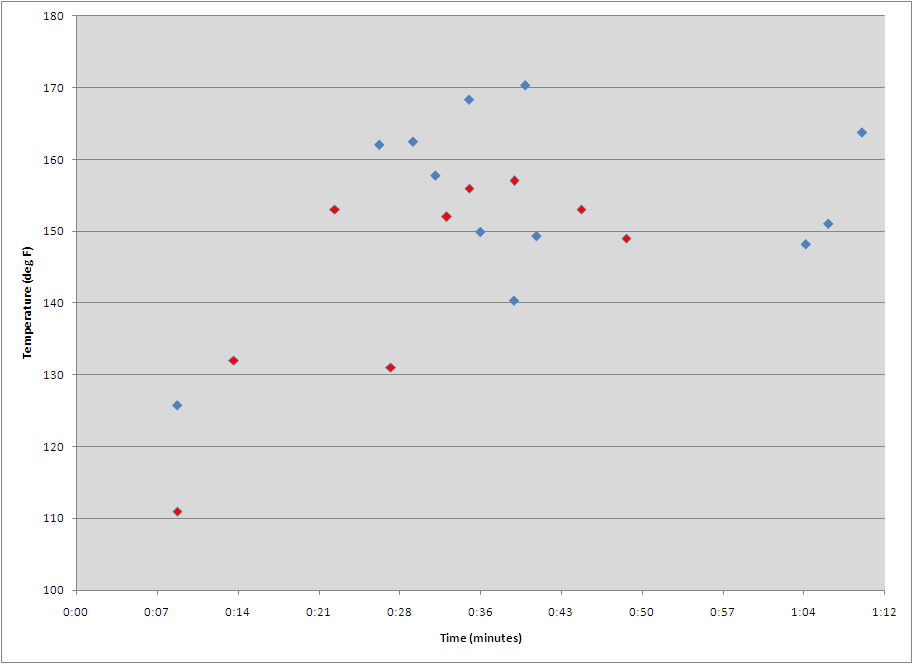Testing of the B5 S4 Intake Manifold Phenolic Spacers
Hypothesis: Vendor claims for phenolic spacers designed for the B5 S4 2.7T motor are correct.
These include:
1) Prevent heat conductivity to the intake manifold from the cylinder head. (034 Motorsports)
2) The intake manifold will be insulated from heat conduction through the heads, leading to lower intake air temps – extends the intake runner lengths for better low end torque. Expect a minimum of 5-10hp at the crank. (VAST Performance)
3) Proven to reduce intake air temps as much as 10%. Reduced intake air temperatures result in better throttle response, maximizes spark advance, and overall increased torque and power. (Autospeed Performance)
4) Radically reduces the heat transfer from the cylinder head to the intake manifold…. gives you up to 5% more power from your engine by reducing the temperature of the incoming air to your engine…. Your intake manifold will stay 30-50° F cooler and your incoming air will stay 20-30° F cooler…. you will be enjoying a more powerful, better performing ride. (NewSouth Performance)
5) Reduce heat by stopping metal to metal contact between the intake manifold and the engine block… reduce the heat of the air entering your engine, making up to 5% more power… allow the intake manifold to perform like an intercooler. Average testing has shown a 25 degrees F drop and up to 35 degrees in some applications. (RAI Motorsport)
Claims for phenolic spacers can be summarized as follows:
1) They insulate the intake manifold from the cylinder head by an unknown amount, reducing heat transfer, or prevent conduction altogether.
2) By lowering the temperature of the intake manifold, by 25-50F, in turn the temperature of the air entering the engine will be lower, by either 10% or 20-30F.
3) The lower intake air temperature will give better throttle response, maximum spark advance, increased torque and either 5-10 more hp at the crank, or 5% more power.
4) By extending the intake runners there will be better low end torque.
Results:
Of these claims I decided to investigate the affect on intake air temperature and intake manifold temperature. The small change in HP and TQ would require a dynometer for measurement and I was not prepared to pay for the multiple sessions that would be required.
Intake Air Temperature:
Upon evaluating the physical construction of an intake manifold it became apparent that trying to determine the affect of the phenolic spacers on intake air temperature on a running motor would be exceptionally difficult. The typical way of addressing changes to intake air temperature are to look at the data being provided by the engines intake air temperature sensor. But this sensor is located just behind the throttle body opening, a distance of 4 cm inside the intake manifold (picture 1). The likelihood of air flowing into the manifold being affected at all by the temperature of the manifold so that the intake air temperature sensor could register such change seems very remote. Consider this, at idle the air is entering the manifold at approximately 40 meters per second, or to put it another way, the air is inside the manifold for roughly 0.09 milliseconds before passing over the intake air temperature sensor.

How the vendors were able to determine that the intake air temperature was lowered is an interesting question since it would require the placement of a temperature sensor at the end of the intake runner just before the cylinder head.
My solution to this challenge was to capture some of the air temperature data when the engine was shut off, this would cause the air inside the manifold to be stationary. The temperature then reported by the air temperature sensor would be more indicative of the condition inside the manifold at that time since the air would have a chance to be warmed by the manifold walls.
The results without phenolic spacers are shown below by the blue lines, and the results with phenolic spacers are shown with the red and yellow lines.

Without phenolic spacers – blue lines; with phenolic spacers – red & yellow lines
Not surprisingly over time the recorded temperature of the air rises as the intake manifold transfers heat into the air. For comparison purposes it becomes necessary to pick a time at which the temperature will be noted, for this comparison a reading 90 seconds after the engine is shut off was recorded. This was done to allow some heating of the air to occur, but it could also be expected that the intake manifold itself would continue to warm up over time, so a reasonable short time period was selected. Figure 2 shows the temperature at 90 seconds, along with how long the car was driven prior to recording the temperature.

Without phenolic spacers – blue diamonds; with phenolic spacers – red diamonds
Based upon these two charts there doesn’t appear to be a distinct difference in the ending temperatures of the intake air within the intake manifold when phenolic spacers are used and when they are not.
Intake Manifold Temperature:
Determining the temperature of the intake manifold was easier in some respects since the exterior surface is exposed. There were two measurements made, the first was with an infrared thermometer at seven marked points on the intake manifold. Six locations were on the intake runners, and the seventh at the center of the component (picture 2). The readings at these locations were taken prior to starting the engine and then immediately upon engine shut off.

The second measurement was made via a temperature sensor that was attached to one of the intake runners. The goal of using this measurement device was to gain some information about how the intake manifold temperature changes over time during operation of the engine (picture 3). A couple of shortcoming to the use of this sensor were that it was exposed to the under hood air on one surface which could influence the reading, and it was located on a single runner so the temperature changes observed would only reflect the changes to one area of the manifold.

Another way to evaluate the effectiveness of the phenolic spacer at insulating the intake manifold from temperature rise is to consider how much the manifold temperature rises during a given driving period. A reading is made prior to driving the car and then immediately upon turning the engine off. This shows how the starting temperature can impact the final values as well as how the duration of the drive can affect the temperature rise. Shown below in figure 3 is the rise in the manifold temperature, obtained by averaging the seven site readings, versus the amount of time the engine was run.

Without phenolic spacers – blue lines; with phenolic spacers – red lines
One obvious conclusion from this data is that for a lower starting manifold temperature, there will be a greater temperature rise. Another observation is that regardless of the starting temperature and the duration of the drive the upper end of the temperature rise will lie within a fairly narrow band from about 150-170 degrees F. There are a couple of factors that can impact these results which are not shown with this chart. The first is the influence that the driving conditions have, for instance stop and go driving versus steady state highway. The other is the ambient air temperature. For these tests a point was made to collect information in temperature conditions that were similar, always above 70F, and predominantly when the temperature was in the mid-80 to mid-90 F range. It is very likely that if the ambient air temperature had been 40F the entire graph of results would have been shifted.
Because the final temperature reading is important that component was broken out and charted separately as well. Figure 4 shows average manifold temperature at the conclusion of driving versus the amount of time the car was driven.

Without phenolic spacers – blue diamonds; with phenolic spacers – red diamonds
Similar to the results that were obtained when recording the intake air temperature 90 seconds following engine shut down, there is no distinct difference between the ending temperatures when the phenolic spacers are added.
How quickly the manifold cooled off was another question I was able to answer. Theorizing that since the manifold was insulated against the temperature of the engine block when the phenolic spacers were in place it seemed possible that the intake manifold might cool off more rapidly than when it was in direct contact with the engine. The next chart shows how much the manifold cools off for a given amount of time that the motor was not running. (figure 4)

Without phenolic spacers – blue diamonds; with phenolic spacers – red diamonds
There is no distinct difference in the rate of cooling for the manifold when the phenolic spacers are used.
The temperature sensor that was attached directly to the manifold allowed observation of the temperature from engine start up and as the intake manifold warmed up. The results of the readings collected this way are shown in figure 5.

Without phenolic spacers – blue lines; with phenolic spacers – red lines
There are several situations illustrated on this chart, and the conditions under which the vehicle is operated determine the temperature change profile.
When the car is started first thing in the morning after a night of cooling down the starting temperature is low, and the temperature rises steadily over time. In the other case, when the car has been driven previously and then sat for some time, it is not uncommon to see the manifold temperature drop for several minutes, and then reverse and begin to climb again. This is occurring because after the car sits the manifold temperature rises. As was shown in figure 4, within an hour or two of engine shut off the manifold temperature is substantially higher than when the engine was running. Even after sitting for 400 minutes, a little more than six and a half hours, the manifold temperature will typically be only 10-15 degrees F cooler than when the engine was shut off.
The rate at which the manifold temperature increases is fairly uniform, only shifting up or down with the initial starting temperature. For both cases there appears to be a point where the temperature begins to level out, occurring around the 20 to 25 minute period.
A couple of extreme cases are shown, in one case with the phenolic spacers in place the temperature rose quite slowly and leveled off and at lower level than all other cases. Coincidentally this occurred on the first collection following installation of the phenolic spacers. It can possibly be explained by the driving style which was very different from the commuting that was done during most of the other collection sessions.
The other extreme cases are when during the drive the temperature readings become so high that they exceeded the temperature sensors displays upper limit. This is shown by the flat line at 160F. This occurred both with and without phenolic spacers in place.
This chart does give some indication that there may be a benefit to using the manifold spacers, so to further evaluate this data the information was aggregated based upon whether the phenolic spacer was used or not, and also by the starting conditions, whether it was a morning start where the manifold had many hours to cool, or if it was a late day start when the manifold temperature was high. Figure 6 shows this break out and collection of the data.

Without phenolic spacers – blue lines; with phenolic spacers – red lines
Morning start – solid lines; afternoon start – dashed lines
This chart shows that there may be a possible affect of the phenolic spacers when the engine has already been run, lasting for the first 20 minutes following engine start, after which the benefit if any becomes uncertain.
For a cold start there does not appear to be any initial benefit.
The trend appears to show that beyond 40 minutes the phenolic spacers might accomplish their stated goal, but this seems unlikely and the downward trend is more likely attributable to the type of sensor being used for the data collecting. From a common sense perspective it doesn’t seem likely that during operation the intake manifold would heat up, and then begin to cool. During nearly all of the data collection sessions for the final minutes of the collection the vehicle was able to be operated at a steady speed which allowed a continuous flow of air through the engine compartment.
Test Shortcomings:
During the installation of the phenolic spacers the intake manifold was also changed from the AE model to the AC. The AC appearing to have slightly less mass, could have skewed the results, but by taking 7 of 8 temperature readings on the intake runner versus the manifold main body the impact will hopefully have been minimized.
As previously mentioned the temperature sensor for the data collection during driving was influenced by the under hood air temperatures. This was applicable in both cases, so the affect would be equal. Also, one further benefit conferred on the phenolic spacers is that by reducing the manifold temperature the engine compartment temperatures will be lowered. With this sensor recording some of the under hood air temperatures that theory appears invalid.
No two collection sessions were the same, so direct comparison was not possible. To overcome this multiple collections were made.
Conclusions:
None of the data collected with the phenolic spacers on the car showed a reduction in the temperature of the intake manifold, or the intake air temperature, as compared to the cases where the phenolic spacers were not in use. The vendor claims are not supported by the data collected during this testing and evaluation.
